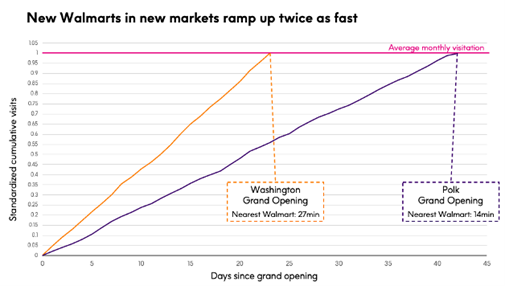
Retail Grand Openings Fizzle If Same-Brand Locations Are Too Close

The ramp up of store traffic for new Big Box and Dollar Stores was over twice as fast when first in the county.
When it comes to navigating and understanding the strategy behind new store openings, customers can leverage data from Precisely PlaceIQ. In any given region, this data helps businesses understand foot traffic to their own locations and their competitors’, find underserved gaps in the market, and support store opening success with advertising campaigns.
Businesses can use Place Intelligence Metrics dataset to analyze the opening performance of similar stores in their target regions, enabling them to be better prepared for a successful grand opening. Critical to that success are the first 30 days. During this time, the store is working to attract new customers and establish a loyal following.
By evaluating new store openings for the purpose of understanding retail recovery, a fascinating pattern was uncovered. The research shows that new store traffic grows remarkably faster when the store is further away from an existing, same-brand location.
This isn’t shocking; a new brand location will garner more excitement if there aren’t any others nearby. However, the results were in fact dramatic and demonstrated that it was consistent from brand to brand. Below, the chart indicates that the Polk, FL Walmart took over six weeks to reach the area’s average traffic. While the new Washington, WI location – serving an audience half an hour away from the nearest established Walmart – met the benchmark in just 24 days.

We looked at other big retailers and again, the principle held consistent. Take a look at Dollar General and BJ’s.

Dollar stores may see a difference of up to 4x in ramp-up rates between new and existing markets. Considering the commonality of seeing multiple dollar stores within 10 miles of one another, the much larger jump may be impacted by high cross shopping and the value of convenience in this category. Warehouse Clubs like BJ’s still see a difference, but less so, as shopping requires a membership commitment and stock-up shopping happens less frequently.
Read our Audience Handbook
Precisely PlaceIQ Syndicated Audience Handbook
Read this handbook and explore real-world audiences to discover new and innovative ways to reach high-value consumers.
This year the retail industry has seen both closures and expansions, as well as brand new retail concepts. Whether a retail company is planning to enter a new market or expand within one, it’s important that they have the right context. Retailers can use location data to build their own models and learn by monitoring competitive openings. Companies can avoid a Grand Opening dud by setting the right traffic benchmarks and advertising based on their market need.
To learn more, read our Precisely PlaceIQ Syndicated Audience Handbook and explore real-world audiences to discover new and innovative ways to reach high-value consumers.
1Place Intelligence Metric (PIM) is a location-based dataset that contains metrics about visitors to a place on a weekly basis. It can be used to analyze a range of visitation behaviors, including trends, seasonality, and visitor attributes. For the purposes of our analysis, we used visitation trends from this dataset between 2021 and 2022.


